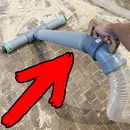Introduction: Homemade Card Scrapers
It's hard to think of a simpler yet more effective woodworking tool than the cabinet scraper – a flat, thin, post card-sized sheet of spring steel dragged by hand across a wood surface to leave a glass-smooth finish. - Macdonald
Some time ago I got my first card scraper. I had been looking for one for a long time. As it turned out I could have made one with materials I already had and thus keep my 8 euros
I also threw together a small video.I hope you like it. It is my first one so don´t go hard on me ;)
Step 1: Stuff Needed
To make scrapers you will need the following materials:
- Putty knife
- Old hand saw
- Old circular saw blade
Tools:
- Angle grinder with metal cutting blade
- metal file
- burnishing tool
- waterstone
- pencil and ruler
Step 2: Putty Knife Scraper
This is probably the easiest one to make.
Just remove the handle and you are done!
I also decided to cut of small strip off so that it would be the same size as my original scraper and that I could use both sides to scrape.
This one has thickness of 0,4 mm. It bends quite easily but it totally works!
Step 3: Hand Saw Scraper
This one turned out the best.
I took old handsaw and removed the handle. I gave it a light sanding to remove rust. Using the already existing scraper I traced out the lines with pencil. I clamped a straight piece of plywood to the blade and cut it with angle grinder. After that I removed the rest of the rust on waterstone.
This scraper has thickness of 0,8 mm.
Step 4: Circular Saw Scraper
Making this one was pretty much like making the hand saw scraper.
Important thing is to use a straight piece of wood to guide your cut.
Otherwise the blade will wonder off and you have to do a lot of filing later on to get it straight.
I would have used a bigger blade but I did not have one. This scraper should be bigger to work comfortably with but it does the job.
This one ended up being 1,2 mm thick.
Step 5: Sharpening and Burnishing
I am not gonna go in much detail with this because there is already so much information on this topic.
The process goes something like this:
- Use metal file to get the edge completely straight ( if it is really beaten up)
- Use waterstone to give it even finer edge.
- Turn the scraper on its side and remove the small burr created from filing.
- Clamp the scraper in the vice and use the burnisher to give the edge a small "hook".
You are done!
Scrapers work also without the hook but will not remove much material like that. Woodworkers use all kinds of tools as burnishers. Screwdrivers, chisels, etc. The key is that the material has to be stronger than the scraper itself. I found a porcelaine knife sharpener from IKEA. This worked perfectly.
As you can see from the pictures different scrapers work differently. The material removed is not only determined by the thickness of the tool but also by the sharpening and burnishing techniques as well as the angle.
Here are some links if you want to know more about sharpening card scrapers:
Step 6: The Conclusion
I am pretty satisfied on how this turned out.
There is no need to spend a lot of money on these tools when you can make thm basically for free.
And of course to keep it all organized I made a small holder for my scrapers and sharpening tools.
Cheers,
Andu

Participated in the
Hand Tools Only Contest 2016

Participated in the
Full Spectrum Laser Contest 2016

Participated in the
Hack Your Day Contest













